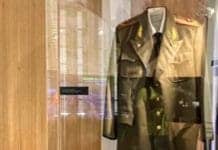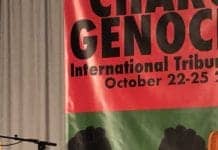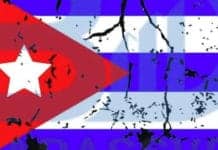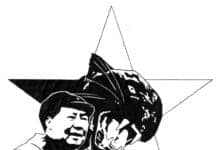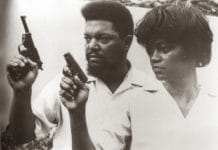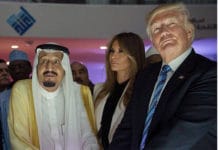
Photo – DOD-Hanning-Rea
by Lamia Oualalou
Choosing to confront the rise in power of left-leaning governments in its backyard, the United States is recreating the Fourth Fleet, with the mission of patrolling Latin American and Caribbean waters. Created during the Second World War to protect traffic in the South Atlantic, the structure was dissolved in 1950.
According to Alejandro Sanchez, an analyst at the Council on Hemispheric Affairs, a research center on Latin America based in Washington, “The reestablishment of the Fourth Fleet is more of a political than a military gesture, designed to confront the rise in power of left-leaning governments in the region.” The Pentagon does not trouble to camouflage its intentions. “The message is clear: whether local governments like it or not, the United States is back after the war in Iraq,” Sanchez explains.
‘New threats’
Washington’s military influence in the region has diminished considerably since Sept. 11, 2001, and the launch of the “war against terrorism.” Concentrating on the Middle Eastern arc of crisis, the Pentagon has not paid much attention to the political upsets in its own backyard. Leftist governments, now broadly in the majority in Latin America, reproach the United States for the support it gave the dictatorships that reigned there and to their ultra-neo-liberal policies.
While Washington assures that its sole interest in the region is combating “new threats” – terrorism, drug trafficking and the Maras gangs of Central America – Latin American people often see it as the pursuit of “imperialist” interests dictated by energy needs. The tensions between Washington and the radical presidents of the sub-continent’s main oil and gas producers – Venezuela, Equator and Bolivia – accentuate that perception.
As a sign of defiance, almost all Latin American countries have refused to sign the American Serviceman Protection Act, a treaty that prevents legal pursuit of American soldiers for crimes committed abroad.
The plan to install a U.S. military base in Paraguay, close to Bolivian gas fields, was denounced by Brazil and Argentina. Ecuador has made it known that the American military base installed in Manta until 2009 will not be allowed to renew its mandate. Worse still, Brazilian president Luiz Inacio Lula da Silva has relaunched the idea of a South American Defense Council, explicitly excluding all United States intervention.
Washington’s sidelining comes at a time when new sources of conflict are arising in the region, as, for example, the one that pits Colombia on one side against Ecuador and Venezuela on the other, or that between Bolivia and Chile over sea access. An arms race is underway in the region, where governments have taken advantage of the economic revival to reequip their armies, neglected since the 1970s.
American arms manufacturers are no longer alone in this market. Some European countries, but especially China, Russia and Iran, are trying to get a footing in a region that also attracts them for its natural resource and energy potential.
Reflections by Comrade Fidel
On Sunday, retired Cuban President Fidel Castro issued this statement:
“[The U.S. Fourth Fleet] had come into being in 1943 as a means of combating Nazi submarines and protecting navigation routes during the Second World War. It was decommissioned in 1950, when it became superfluous. The South Command was designed to meet the United States’ hegemonic needs in our region at the time.
“After 48 years, however, it has recently been resurrected, and its interventionist aims need not be proved: U.S. military chiefs themselves divulge these in their declarations in a natural, spontaneous, at times discrete fashion. Overwhelmed by problems with food prices, energy, unequal trade, the economic recession which affects the most important market their products have, inflation, climate change and the investments required to satisfy their consumer dreams, they mismanage the time and energy of leaders and subordinates alike.
“Truth is, the decision to reassemble the Fourth Fleet was announced the first week of April, almost a month after the Ecuadorian territory was attacked with U.S. bombs and technology and when, owing to U.S. pressures, citizens of different countries were killed or wounded. This was vigorously condemned by Latin American leaders at the Rio Group meeting held in the Dominican Republic’s capital.
“But worst still is that this is taking place at a time when the dismemberment of Bolivia encouraged by the United States meets with nearly unanimous condemnation. U.S. military chiefs themselves have explained they will be responsible for over 30 countries and for covering 15.6 million square miles of neighboring waters in both Central and South America, the Caribbean Sea and its 12 islands, Mexico and the European territories this side of the Atlantic.
“The United States has 10 Nimitz aircraft carriers whose parameters, more or less similar, are the following: maximum load capacity of between 101,000 and 104,000 tons; a deck that’s 999 feet long by 230.4 feet wide; two nuclear reactors; maximum speed of 35 miles per hour; capacity for 90 war planes. The last to be commissioned bears the name of George H.W. Bush, the current president’s father. It has already been baptized with a bottle of champagne by the progenitor himself and should be ready to join the other vessels in the coming months.
“No other country in the world can boast of a vessel like these, equipped with sophisticated nuclear weapons, able to get within a few miles of any of our countries. The next aircraft carrier to be commissioned, the USS Gerald Ford, will be a new type of vessel which employs stealth technologies that cannot be detected by radars and electromagnetic weapons.
“The main manufacturer of the two types of vessels is Northrop Grumman, whose current president is also a member of the board of directors of the U.S. oil company Chevron-Texaco. The last Nimitz cost $6 million. This did not include the cost of the planes, projectiles or operations, which can reach figures in the billions. It sounds like a science fiction story. With that money, the lives of millions of children could have been saved.
“What is the declared objective of the Fourth Fleet? ‘To combat terrorism and illegal activities such as drug trafficking,’ not to mention sending a message to Venezuela and the rest of the region. It has been announced that it will begin operations next July 1.
“Head of the South Command U.S. Navy Admiral James Stavrides has stated that the United States needs to work harder in ‘the market of ideas, to win over the hearts and minds’ of the people in the region.
“The United States has already deployed the Second, Third, Fifth, Sixth and Seventh fleets in the Western Atlantic, Eastern Pacific, Middle Eastern, Mediterranean, Eastern Atlantic and Western Pacific Oceans. The Fourth Fleet was needed to patrol all the seas worldwide. The United States has a total of nine Nimitz aircraft carriers, active or nearly ready for combat, such as the George H.W. Bush. It has sufficient reserves to triple or quadruple the power of any of its fleets in a given theater of operations.
“The aircraft carriers and nuclear bombs our countries are threatened with serve to spread terror and death, but not to combat terrorism and illegal activities.
“They should also serve to fill the empire’s lackeys with shame and strengthen solidarity among the peoples.”
The story by Lamia Oualalou, not including President Castro’s statement, first appeared in Le Figaro of Paris. Truthout French language editor Leslie Thatcher translated it into English for publication in Truthout, at www.truthout.org/docs_2006/050208G.shtml. The statement by Fidel Castro is posted at www.cuba.cu/gobierno/reflexiones/2008/ing/f040508i.html. It was forwarded to the Bay View by Roland Shepherd.

 Store
Store



